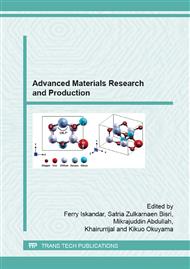p.308
p.313
p.317
p.323
p.329
p.333
p.338
p.345
p.349
Correlation between Frequency and Sound Absorption Coefficient of Polymer Reinforced Natural Fibre
Abstract:
Aspect ratio which is the ratio between the length and diameter of the fiber affects the sound absorption performance of the polymer reinforced natural fiber (ramie or bamboo fiber). The aim of this study is to choose the specific frequency –which is important for industrial application- to obtain an optimal sound absorption coefficient (α) by designing a certain aspect ratio.The acoustic was measured using impedance tube of The ASTM E- 1050=98 standard. Fiber length was 10 mm, while the diameter of the fiber was measured by using a digital optical microscope measurement with an average diameter of 110.4 microns. The morphology of the material was observed by using scanning electron microscope (SEM). Fourier Transform Infrared (FTIR) spectroscopy was used to identify the presence of certain functional groups in a molecule. The results indicated that the average of the sound absorption coefficient of the polymer reinforced ramie fiber reached 0,836 at low frequency of 125 Hz and 0,537 at medium frequency of 1000 Hz, and aspect ratio of 90, while the sound absorption coefficient of the polyester material reinforced bamboo fiber reached 0.973 at medium frequency of 1000 Hz.
Info:
Periodical:
Pages:
329-332
Citation:
Online since:
July 2015
Keywords:
Price:
Сopyright:
© 2015 Trans Tech Publications Ltd. All Rights Reserved
Share:
Citation:


